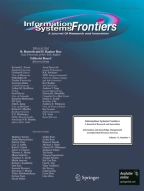
Artificial intelligence (AI) and blockchain are the two disruptive technologies emerging from the Fourth Industrial Revolution (IR4.0) that have introduced radical shifts in the industry. The amalgamation of AI and blockchain holds tremendous potential to create new business models enabled through digitalization. Although research on the application and convergence of AI and blockchain exists, our understanding of the utility of its integration for business remains fragmented. To address this gap, this study aims to characterize the applications and benefits of integrated AI and blockchain platforms across different verticals of business. Using bibliometric analysis, this study reveals the most influential articles on the subject based on their publications, citations, and importance in the intellectual network. Using content analysis, this study sheds light on the subject’s intellectual structure, which is underpinned by four major thematic clusters focusing on supply chains, healthcare, secure transactions, and finance and accounting. The study concludes with 10 application areas in business that can benefit from these technologies.
Avoid common mistakes on your manuscript.
Artificial intelligence (AI) is a technology that can perform complex tasks that require human intelligence, and it holds the potential of exceeding human capabilities (Agarwal et al., 2020; Pandl et al., 2020). AI is one of the main drivers of industrial development as it promotes the integration of emerging technologies in the Fourth Industrial Revolution (IR 4.0) (Goodell et al., 2021; Lim, 2019; Zhang et al., 2021), such as blockchain (Ehrenberg & King, 2020), cryptocurrency (Li & Whinston, 2020), cloud computing (Hsu, 2020), and internet of things (IoT) (Ghaleb et al., 2021). Indeed, the massive amount of data generated by IoT devices, social media, and web applications has fueled the proliferation of AI, wherein the data is utilized in the training of machine learning algorithms (Dinh & Thai, 2018). However, some concerns associated with AI exists. Specifically, privacy has become a critical concern as a result of a series of leaks and misuse of personal data. The Facebook scandal in which millions of users were targeted without consent by Cambridge Analytica, a third-party political firm, is one such example. Other growing concerns with AI include explainability and trustworthiness as the technology does not interact or speak with human users and thus cannot be verified or trusted (Dinh & Thai, 2018).
Likewise, blockchain has gained increasing attention as a technology with a wide range of applications in various fields (Dinh & Thai, 2018; Liu et al., 2019a). Blockchain, which became popular after the emergence of bitcoin in 2008 (Nakamoto, 2008), has remained as a disruptive technology that transforms the way we interact, trace transactions, and automate payments, among others (Roszkowska, 2020). Indeed, blockchain has opened the door of opportunities that enables the direct transference of value between its users in a secure and trusted manner. Moreover, with the execution of smart contracts, the checking of approvals and compliances can become simpler, as blockchain is a shared database that is synchronized across multiple sites, and thus, such activities can be agreed on by each participant in a distributed network (Soleymani & Paquet, 2020). The data in blockchain is stored in blocks with hash values and timestamps, wherein the blocks are created based on a consensus protocol such as a proof of work or a proof of stake (Dinh & Thai, 2018)—proof of stake is less expensive than proof of work due to higher energy efficiency (Karafiloski & Mishev, 2017). More importantly, all transactions are cryptographically signed on blockchain, wherein all mining nodes that hold a copy of the entire ledger verify every single transaction on the blockchain (Nakamoto, 2008; Zheng et al., 2017). Therefore, blockchain is cost effective and secure as it eliminates the need for a centralized authority to verify the transactions (Karafiloski & Mishev, 2017; Zhu et al., 2021).
The developments of AI and blockchain has propelled their integration to revolutionize the next digital generation ignited by IR 4.0. According to Salah et al. (2019), blockchain can offer explainability, privacy, and trust to AI-based applications, whereas AI can enhance scalability and security while resolving the personalization and governance issues for blockchain-based technologies. As indicated in Table 1, AI and blockchain are technically different in various ways, but they can be used to overcome the shortcomings of each other. In that sense, AI and blockchain are the yin and yang of digital business, wherein AI helps the business to understand, recognize, and decide, whereas blockchain supports the business to execute, verify, and record (Morrison, 2016).
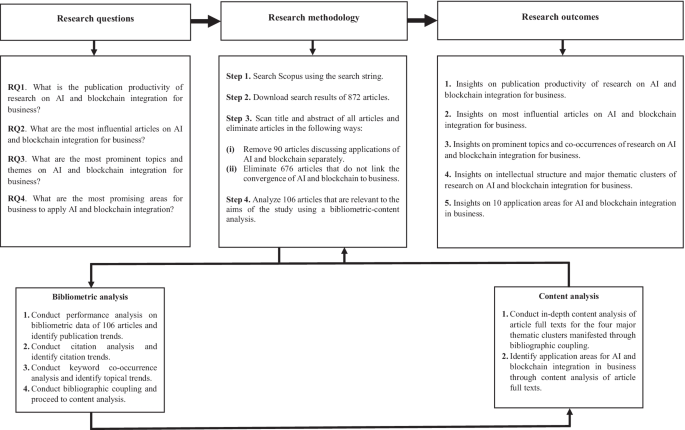
The present study aims to shed light on the bibliometric and intellectual structure of the extant literature pertaining to AI and blockchain integration for business. The bibliometric structure encapsulates the publication productivity, whereas the intellectual structure pertains to the major topics and themes of research in the area under study. The scope for study is relatively large, as AI and blockchain are rich areas of research.
The present study employs a combination of bibliometric and content analysis techniques to map the development of the literature pertaining to AI and blockchain integration for business. In particular, the study conducts a performance analysis using a variety of bibliometric measures such as citations, cite score, impact factor, publication count, and h-index, as well as keyword co-occurrence analysis and bibliographic coupling to unpack the major topics and themes in the research field, which subsequently informs the authors’ reading of article full text for the content analysis.
To identify the articles and associated bibliometric and bibliographic data for analysis, the authors engaged in brainstorming with subject-matter experts on AI and blockchain to develop the keywords to be included for the search. In essence, the concept of “AI-enabled blockchain” is an amalgamation of two technologies, namely AI and blockchain. In order to ensure that both of these concepts are comprehensively captured by the search keywords, the authors included a search string for data search comprising of keywords covering the two technologies, as presented in Table 4.
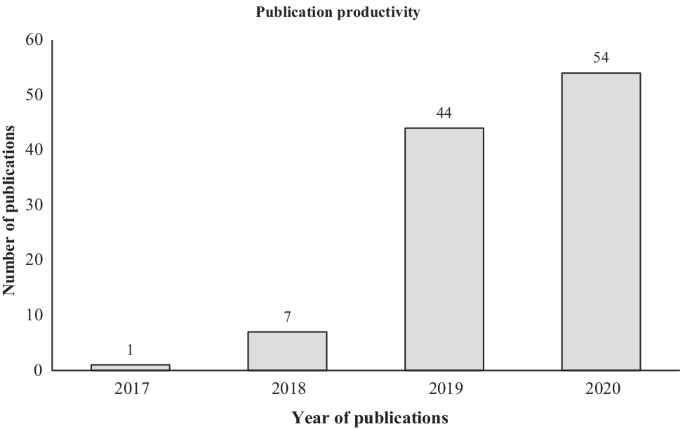
To answer RQ2—i.e., what are the most influential articles on AI and blockchain integration for business—the study conducts a performance analysis by means of citation network for the 106 articles under review. There are several metrics to measure the influence of a publication, but the most prevalent metric is citations (Ding & Cronin, 2011), wherein the influence of a publication is assessed through the number of times it is cited by other publications (Donthu et al., 2021a). VOSviewer and Gephi software were employed to derive the citation network between publications. Figure 3 presents the citation network among publications and Table 6 shows the leading original articles by the number of citations. Mamoshina et al.’s (2018) article on the convergence of AI and blockchain in healthcare tops the list with 102 citations, followed by Liu et al.’s (2019b) article on performance optimization for blockchain-enabled IoT systems and Mao et al.’s (2018) article on credit evaluation system based on LSTM and blockchain with 47 and 44 citations, respectively.
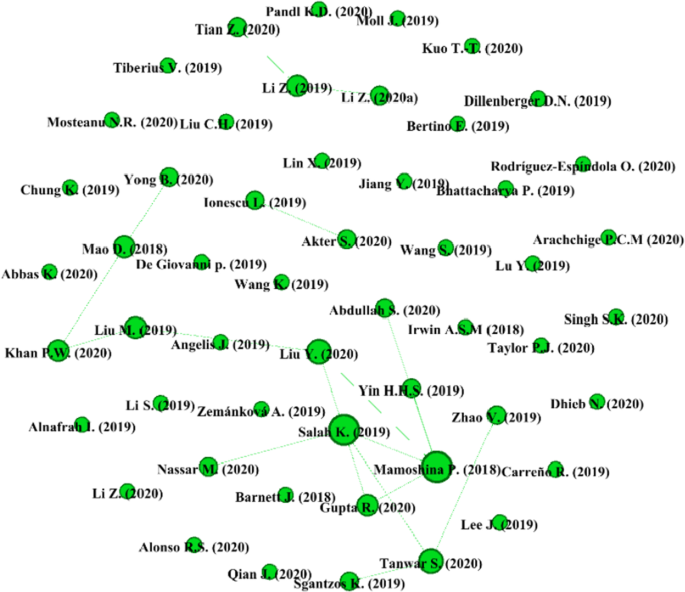
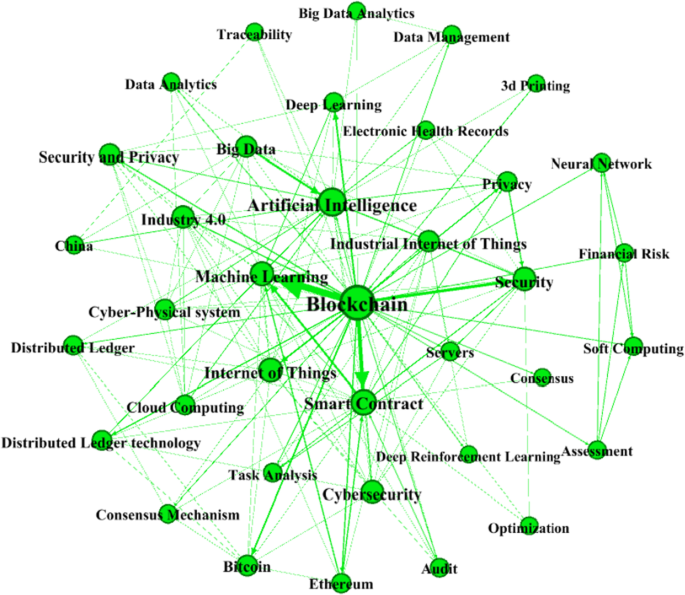
The top 20 keywords based on their occurrences are presented in Table 8. Blockchain is the most prominent keyword in the list with 74 occurrences, followed by artificial intelligence (31), smart contract (22), machine learning (19), and internet of things (13). All these keywords are a reflection of the scope of publications in the dataset. More importantly, the keywords are consistent with the line of enquiry of the present study as they reflect the core technologies that can be employed and integrated for the automation and optimization of business in IR 4.0. The top 20 keyword pairs based on their co-occurrences are presented in Table 9. The keyword pairs are ranked on the basis of their strength or weight of association. The three most strongly associated keyword pairs are “blockchain and machine learning”, “blockchain and smart contract”, and “blockchain and security”. The sturdiest association of blockchain and machine learning signals that the dataset herein is representative of investigations that focus on the integration of AI and blockchain, wherein machine learning is the main form of AI relevant for business. The network among keywords is presented in Fig. 4. The size of the node represents the occurrence of the keyword, whereas the link between nodes and the thickness of that link represent the co-occurrence between keywords and the degree of that co-occurrence. Here, the topic network illustrates that artificial intelligence, blockchain, machine learning, internet of things, and smart contract are the most prominent nodes in the network that occur and co-occur most frequently together as well with other topical keywords, and thus, highlighting their relative importance in the field.
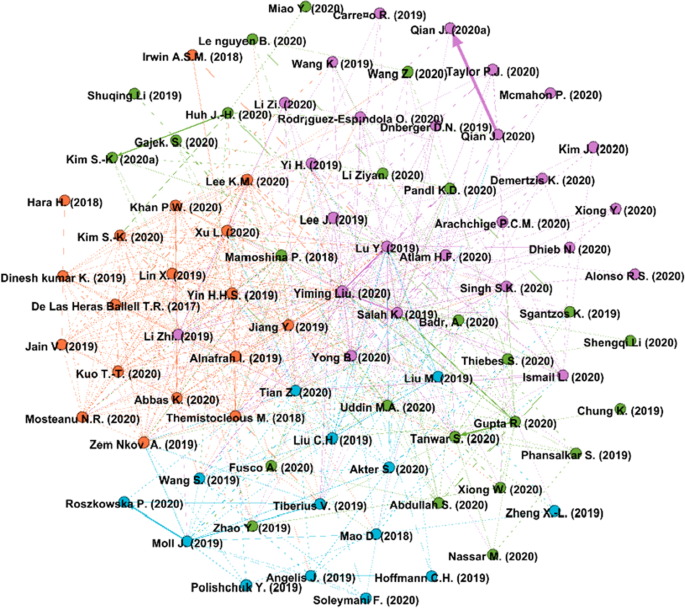
The clusters are also analyzed using content analysis and the findings are presented based on their respective size, which is derived based on the associated number of publications.
Cluster 1 consists of 25 articles that have been cited 471 times. The articles in this cluster discuss about the developments of IR 4.0, wherein the concepts of artificial intelligence, blockchain, supply chain, and traceability appear prominently in the cluster’s word cloud in Fig. 6. Indeed, the topical concepts resonate to the integration of AI and blockchain as the prominent technologies that characterize the latest industrial revolution and that facilitate the automation business. Though IR 4.0 has created numerous opportunities to improve operations (Chen et al., 2022; Liu et al., 2019a; Rodríguez-Espíndola et al., 2020), the articles that organically manifested in this cluster through bibliographic coupling are focused on the optimization of supply chains, which is an activity that transcends across different industries.
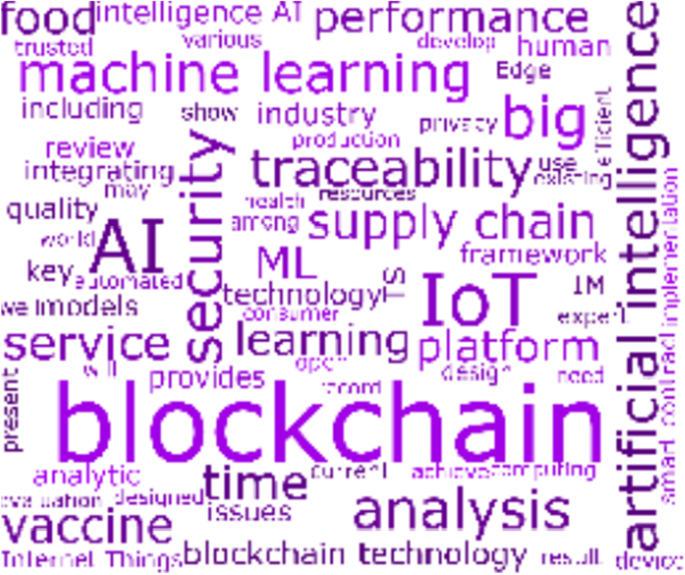
Arachchige et al. (2020) describes IIoT as a driving force for IR 4.0 in business and explains how IIoT utilizes machine learning to manage large volumes of IIoT data that is prone to privacy adversarial attacks. Machine learning analyzes massive quantities of sensitive data produced by IIoT-based systems. There are high chances that machine learning models can compromise the confidential data to adversaries. The authors propose a PriModChain that amalgamates ethereum blockchain, smart contracts, federated machine learning, and differential privacy in order to enforce privacy and thus ensure trustworthiness of IIoT data. The privacy of the input data is strengthened using differential privacy whereas smart contracts offer transparency to the proposed technology (Ehrenberg & King, 2020; Han et al., 2021).
IR 4.0 has also led to enormous improvement in production efficiency in manufacturing systems. Cyber physical systems (CPS) combine various technologies such as AI, cloud computing, deep learning, and edge computing to control physical processes in manufacturing and to supervise the operations of self-organizing processes (Lu, 2017). However, CPS depends on third-party trust operations and centralized industrial networks due to which manufacturing processes suffer problems such as security, transparency, privacy, trustworthiness, and efficiency. Lee et al. (2019) proposes a three-layer blockchain enabled cyber physical system (BCPS) for to address these issues.
Additionally, a technically sound evaluation system can improve the production efficiency of manufacturing systems. Companies choose suppliers based on their production capability. However, conventional production capability evaluation systems are based on a centralized approach where there is limited sharing of performance data. Li et al. (2020) proposes a production capability evaluation system based on machine learning, IoT, and blockchain technology that can collect data in real time to support an automated enterprise production capability evaluation mechanism. In this instance, blockchain technology facilitates fair and automatic data trading through open and decentralized data storage.
Nonetheless, supply chains are vulnerable to different types of security and privacy threats—for example, in vaccine supply chains, issues such as vaccine record fraud and vaccine expiration are prevalent. Yong et al. (2020) highlight such issues and propose an intelligent system in which blockchain technology enables vaccine supervision, smart contracts detect expired vaccines, and machine learning algorithms provide vaccine recommendation information to different users. Similarly, in the dairy industry, it is important to provide detailed product information to consumers to ensure the quality and safety of the product. In order to enable traceability and resource monitoring in the value chain, Alonso et al. (2020) introduce a platform that applies AI, blockchain, edge computing, and IoT. The technology monitors the state of feed grains and dairy cattle in real time and ensure the traceability of production processes. Finally, Rodríguez-Espíndola et al. (2020) highlight the challenges in the flow of products, information, and financial resources in humanitarian supply chains and explain how the integration of AI, blockchain, and 3D printing can solve such problems.
Cluster 2 comprises 24 articles that have been cited 259 times. The main focus of the articles in this cluster is on the healthcare industry, wherein the concepts of artificial intelligence, blockchain, health, healthcare, and patient appear prominently in the cluster’s word cloud in Fig. 7.
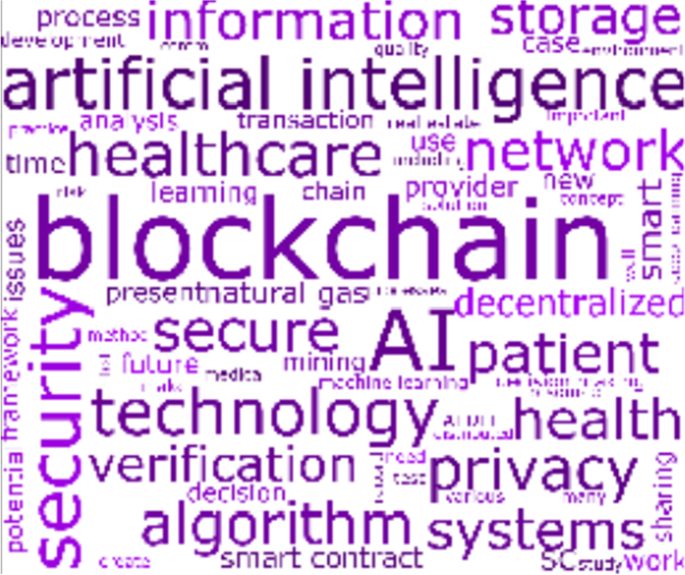
In healthcare industry, the combination of AI and blockchain can help to address the issues related to medical data privacy (Klinker et al., 2019). Kim and Huh (2020) shed light on a medical information system using AI and blockchain technology. The paper shows the performance verification of the system using error backpropagation blockchain framework, wherein the proposed technology guarantees the integrity of the system by preventing forgery and misrepresentation of medical data using neural networks.
Wang et al. (2020) propose a scheme for preserving health data known as GuardHealth, which is based on consortium blockchain and two smart contracts for data storage and data sharing. The system provides data privacy and security by encrypting health data before uploading it to the cloud service provider by using proxy re-encryption. The proposed scheme also introduces a malicious node detection approach through graph convolution network that can build trust and guarantee security of the system.
Mamoshina et al. (2018) introduce the concept of AI-mediated health data exchange on blockchain and explain how blockchain technology and AI can enable patients to control their own medical records. The authors shed light on the application of transfer learning techniques and recurrent neural networks to the blockchain-enabled personal data marketplace that can further lead to various types of predictive analysis about the patient’s health, wherein the results of the predictive analysis can be helpful to pharmaceutical and insurance companies. The authors also propose a personal data-driven economy in which patients have complete control over their data and manage the access privileges to protect their data privacy. The system allows patients to be rewarded for generating new data and offering the data for research and commercial use.
More recently, Fusco et al. (2020) propose a predictive system based on the combination of AI and blockchain that can contribute to controlling the risk of COVID-19 in a national territory. Here, the predictive system can be autonomously and constantly updated with clinical data of patients, which in turn, can create big data suitable for informing health policy at the national level, and thus, demonstrating how business can support government in times of crisis.
Finally, with the exponential growth in digital health data and the increase in the variety of data repositories, Uddin et al. (2020) present a predictive model for intelligent storage allocation decision for health data, wherein a machine learning classifier maps the type of health data with the features of storage repositories before allocating that data to the blockchain-based repository. Similarly, Badré et al. (2020) introduce the concept of shared decision making in integrated health services and propose a decentralized patient assignment system that uses machine learning, blockchain technology, and integer programming to improve the coordination among healthcare providers and patients.
Cluster 3 contains 18 articles with 119 citations. The articles in this cluster encapsulate the risks associated with online transactions and the equivalent solutions to make such transactions secured, wherein the concepts of blockchain, business, finance, machine learning, and transactions appear prominently in the cluster’s word cloud in Fig. 8. In this cluster, it is observed that the high level of anonymity of cryptocurrencies makes them a fertile ground for illicit activities (Sun Yin et al., 2019). Indeed, law enforcement agencies have experience challenges in tracking down the identity of illegal cryptocurrency users and their transactions (Irwin & Turner, 2018).
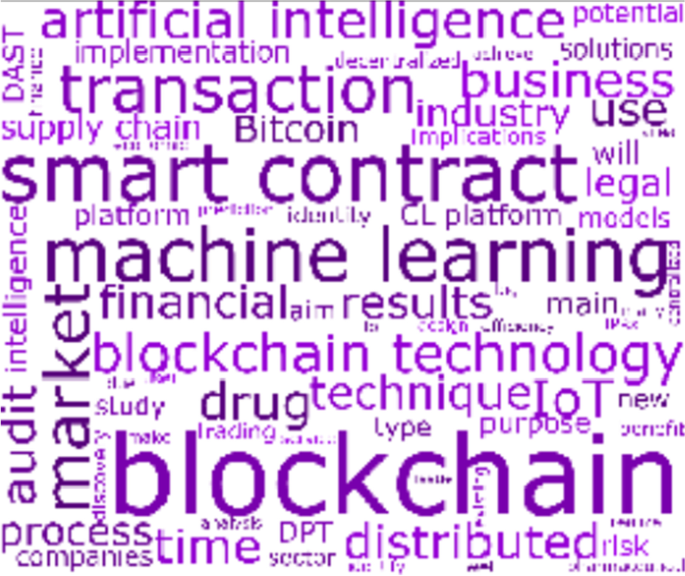
To address the issue of intentional illicit transactions, Sun Yin et al. (2019) propose a method to de-anonymize bitcoin blockchain by employing a supervised machine learning approach, wherein the method helps to identify high risk bitcoin users and their potential cybercriminal activities. The author uses gradient boosting algorithm to uncover the anonymity of the parties.
Similarly, Irwin and Turner (2018) suggest an optimal solution based on a machine learning architecture that has predictive capabilities, wherein the solution enables predictive policing by collecting and analyzing data from bitcoin blockchain. The proposed technology collects data from bitcoin blockchain and identifies suspicious behaviors of bitcoin users by applying search criteria matching, indexing, and clustering on data. Moreover, the system encourages data sharing between cyber security organizations, the FinTech industry, and law enforcement and financial intelligence units, which will eventually enable law enforcement agencies to trace the identity of illegal bitcoin users.
To address the issue of unintentional illicit transactions, Jain et al. (2019) propose a unique solution to mitigate the risk of identity theft in the case of online transactions. Their system, which is founded on the amalgamation of machine learning, blockchain, IoT, and online signature verification, performs cryptocurrency transactions without using a private key. The verification of the transaction is done through dynamically generated handwritten signature, which is performed through specialized pen implanted with accelerometer and gyroscope. The handwritten signatures are authenticated through dynamic time warping algorithm.
Finally, de las Heras Ballell (2017) points out the imperfections of secured transaction legal systems and suggests that the integration of AI, IoT, and smart contract can remedy these imperfections and make the system more effective and secure. In secured transactions, the monitoring of collaterals bears significant transaction cost. Smart contracts and IoT can enable creditors to monitor encumbered assets in a cost-effective way, directly supervising compliance and instantly detecting infringement. Additionally, AI solutions embedded in smart contracts can mitigate the risk of funds recovery in case of insolvency, earmarking potential risk of obligations not being fulfilled due to unexpected events and making it technically impossible not to comply with agreed contractual terms. Therefore, the deployment of smart contract with the decision-making process of artificial technology and data collected by IoT solutions can enable a comprehensive contractual framework for authentic transactions.
Cluster 4 is the smallest cluster with 14 articles that have been cited 240 times. The articles in this cluster concentrate on the finance and accounting industry, wherein the concepts of accounting, auditing, blockchain, business, financial, and smart contract appear prominently in the cluster’s word cloud in Fig. 9.
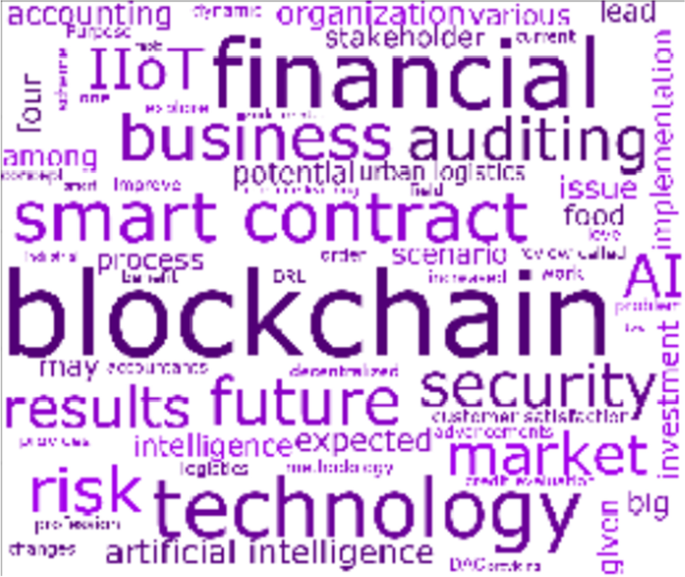
In this cluster, it is observed that the integrated application of AI and blockchain can improve the processes in the industry. The use of information technologies can automate accounting decisions to a large extent and transform the everyday work of accountants (Moll & Yigitbasioglu, 2019). Zheng et al. (2019), who explain the three stages of technology-driven financial upgrading, shed light on FinTech 3.0, which involves the integration of technologies such as AI, big data, blockchain, and cloud computing with finance to achieve automated and secured financial transactions leading to improved service efficiency and reduced cost. Similarly, Soleymani and Paquet (2020) introduce an online framework for financial portfolio management and optimization using a deep reinforcement learning called DeepBreath. The convolutional neural network is used to implement investment policy based on which assets are reallocated in the portfolio to increase the return on investment, and the blockchain technology is used to reduce the settlement risk occurring due to delay between acquisition of asset and its payment.
In addition, the articles in this cluster explain how integrated AI and blockchain platforms can help to tackle problems such as corporate frauds and credit risk. Roszkowska (2020) discusses corporate frauds caused by the failure of the auditor to detect such frauds and argues how FinTech offers an effective solution to such issues, wherein the combined implementation of blockchain, smart contracts, and advanced AI solutions can overcome the deficiencies of financial reporting and auditing. Similarly, Mao et al. (2018) highlight the problem of credit risk caused by the information asymmetry between traders and propose a credit evaluation system that is implemented by integrating blockchain technology and the long short term memory (LSTM) deep learning network. This system uses smart contract to collect credit evaluation data and analyze it using LSTM. Indeed, the proposed system is an exemplar of how the integration of AI and blockchain can help to ensure the authenticity of information about credit evaluation and the verification of ensuing financial transactions by traders.
To answer RQ4—i.e., what are the most promising areas for business to apply AI and blockchain integration—the study scans the review corpus using a content analysis and the ensuing findings are presented in Table 10, wherein 10 promising areas for potential application of these hallmark IR 4.0 technologies are earmarked and explained with application exemplars and their associated technologies, value, and source.
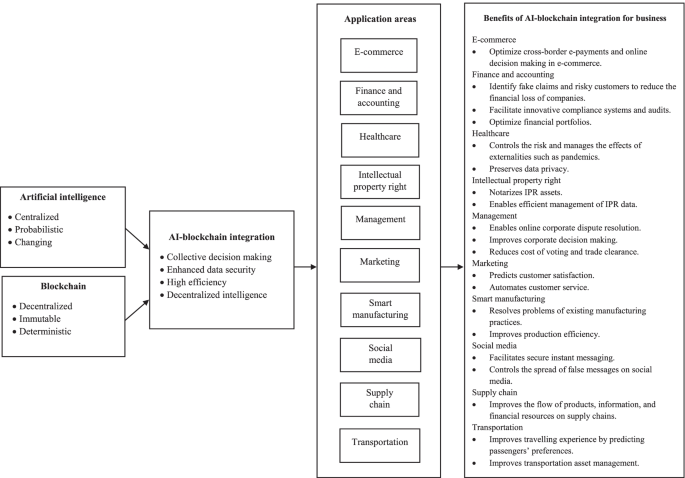
AI and blockchain are two of the hallmark technologies of IR 4.0. Although the two technologies are relatively different in their own ways, the subject of amalgamation has received interest among scholars and professionals alike. Yet, there is a scarcity of research that consolidates and examines the state-of-the-art insights on the applications of integrated AI and blockchain platforms in business. The present study sought to address this gap through a bibliometric-content analysis, and in doing so, provides five key takeaways.
First, the study clarifies that AI and blockchain are IR 4.0 technologies that were introduced in 2016, with early research that integrates the two technologies for business emerging in 2017 but proliferated exponentially only from 2019 onwards. Here, the proliferation of research witnessed reaffirms the study’s contention that AI and blockchain integration holds immense promise for business applications.
Second, the study identifies Mamoshina et al.’s (2018) article on the convergence of AI and blockchain in healthcare, Liu et al.’s (2019b) article on performance optimization for blockchain-enabled IoT systems, and Mao et al.’s (2018) article on credit evaluation system based on LSTM and blockchain as the most influential articles on AI and blockchain integration for business. It is important that prospective authors are cognizant of the seminal articles in the field in order to position and design future research in novel ways to extend the knowledge of prior research.
Third, the study reveals that “blockchain and machine learning”, “blockchain and smart contract”, and “blockchain and security” are the most popular topics for research, and the revelation of “blockchain and machine learning” as the sturdiest association in the corpus is another source of triangulation to highlight the promise and importance of AI and blockchain integration in business, wherein machine learning is the AI technology that seems to be most relevant and sought after for business endeavors.
Fourth, the study unpacks four major thematic clusters that underpins the intellectual structure of research relating to AI and blockchain integration for business, namely IR 4.0 and supply chains, smart healthcare, secure transactions, and finance and accounting. Here, two clusters are generic and thus transcend across industries (i.e., IR 4.0 and supply chains and secure transactions) and two clusters are specific and thus industry focused (i.e., smart healthcare and finance and accounting). The small number of major thematic clusters is an indication that research on AI and blockchain integration for business is relatively new, and thus, research that spurs its continued growth to enrich existing clusters and to propel the emergence of new clusters is highly encouraged.
Fifth, the study reveals 10 areas for AI and blockchain integration in business suggested by existing studies in the field, namely e-commerce; finance and accounting; healthcare; intellectual property right; management; marketing; smart manufacturing; social media; supply chain; and transportation, wherein exemplars of integrating the two IR 4.0 hallmark technologies for business endeavors are offered alongside its potential value and sources.
To this end, this article has contributed in four major ways. First, this article has mapped the publication productivity of AI and blockchain integration for business, showing that the field remains in its infancy and has tremendous scope for growth and future research. Second, this article has identified the most influential articles in the field, thereby laying the foundation for future research to build on the seminal insights curated herein. Third, this article has unpacked the most prominent topics and themes on AI and blockchain integration for business, which enables prospective authors to gain a one-stop state-of-the-art insights of literature in the field. Fourth and finally, this article has revealed 10 application areas for AI and blockchain integration in business, which should be useful for business professionals who wish to leverage on scholarly research to identify areas for business transformation using the two IR 4.0 technologies, including exemplars that they could follow.
This article also delivers important implications to different stakeholders, including business managers, AI and blockchain developers, information technology (IT) vendors, and future scholars. For business managers, the knowledge about the potential of integrating AI and blockchain in business can encourage them to develop and implement projects utilizing both these technologies to foster resilient business operations and improve the performance of firms (Fosso Wamba & Queiroz, 2021; Rubin et al., 2021). AI and blockchain developers also stand to gain acute insights on how integrating these two technologies creates business synergy. Therefore, AI and blockchain developers can collaborate to develop automated and decentralized business applications that offer better governance, higher performance, and greater security of user confidentiality and privacy (Siala & Wang, 2022). IT vendors will also be able to better identify the market for AI and blockchain business solutions and position the value they bring through the identified areas for AI and blockchain integration in business. Finally, future scholars will be able to advance knowledge in the field by building on the current overview of AI and blockchain integration in business and venturing into new areas that would create new streams or enrich existing streams of research in the field. In this way, this article empowers both professionals and scholars with state-of-the-art insights so that they will be aware of the opportunities for AI and blockchain integration to enhance the growth, resilience, and robustness of business practices.
Nonetheless, this article, like any others, concedes its limitations. First, the data in this article is bounded by the accuracy and completeness of its source, and in this case, Scopus. It is important to note that Scopus, as a scientific database, was not developed for bibliometric analysis, and thus, may contain (unintended) errors. To mitigate potential (unintended) errors, the authors have ensured that they cleaned the bibliometric data retrieved from Scopus to the best of their ability, wherein duplicates and erroneous entries are removed, as recommended by Donthu et al. (2021a). Second, AI and blockchain integration is a dynamic field of research and a radical transformation in practice. In that sense, new innovations in its application and integration are expected, and thus, new streams of research are likely to proliferate rapidly. Therefore, prospective authors should not only rely on the review insights herein, but also to keep themselves updated with the latest research in the field, which can be done by using the search string herein this study.
Moving forward, prospective authors interested in conducting new research on the integration of AI and blockchain for business are encouraged to invest their efforts to uncover the application of such an integration from a business rather than engineering lens, as the study herein flagged the scarcity of insights emerging from business research. To fertilize such endeavors, this article calls for new research that answers the non-exhaustive research questions on AI and blockchain integration through a business lens in general and by cluster, which we summarize in Table 11.
Table 11 Future research questions on AI and blockchain integration through a business lensIn short, this article makes clear that AI and blockchain integration is a global and legitimate phenomenon that holds tremendous promise for business, and that future research in this area should be enriched from the business perspective in order to complement the solutions offered through the engineering perspective and move the field forward. It is hoped that the insights herein this article will be useful for gaining a one-stop understanding of AI and blockchain integration as well as some prospective avenues for future research in the area through a business lens.
Open Access funding enabled and organized by CAUL and its Member Institutions